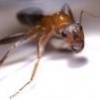So, I went up the river where there are a bunch of Pogonomyrmex californicus nests. In Irvine (Southern California). I actually forgot they flew really recently (like yesterday I think?), and ended up getting lots of queens. All were busy digging nests, except one queen was just running on the road and probably trying to find a place to make a colony. I got a bit too many (nine queens, only had room for five), so I put the remaining queens into my garden. Maybe they'll make a colony there and there will be Pogonomyrmex around.
The other five queens I put all into their own containers. I boosted them all with the same species of brood. Mostly pupae, and some larvae. It might not be as fun/rewarding to start with boosted brood. But, I want successful colony(ies) which is far more important to me, so each queen got some brood. One queen got callow ants.
I put one queen into Drew's formicarium I bought from him. And actually, this queen is the least aggressive queens I got out of the five. Probably the least aggressive Pogonomyrmex californicus queen I've encountered. I put 3-4 callow ants (must have eclosed recently as they didn't have their red color) and they accepted each other right away. Maybe the queen came from the same colony by chance or something. Still doesn't even act aggressive toward me. I did try putting a callow ant with another queen, but she is far more aggressive and wasn't having any of it. All five accepted the brood I gave them, however.
In total, I gave around 20-30 pupae to the queens, and 10 or so larvae. I didn't really count to be honest as I was too focused on transfering the brood without injuring them to each queen. The queen in Drew's formicarium got the most brood+the callow ants. The others all got around 5-8 pupae and 1-3 larvae.
Edited by Vendayn, June 20 2015 - 9:59 PM.




















